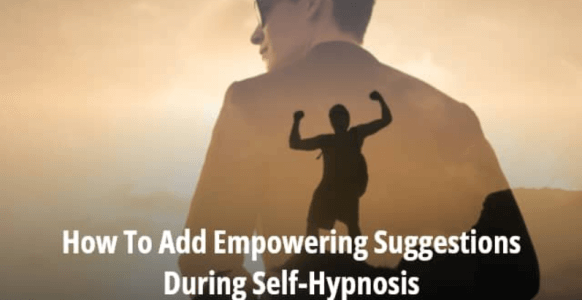
Self-hypnosis is often described as a tool for transformation—and rightly so. It gives you access to your unconscious mind, that deep inner space where beliefs, habits, and emotional patterns reside. But what many people overlook is this: the real magic of self-hypnosis doesn’t just happen in the trance. It happens through the suggestions you give yourself while in that state.
A suggestion is more than a phrase. It’s a bridge between who you are and who you’re becoming.
But here’s the challenge: not every suggestion works. In fact, many well-meaning affirmations fail to take root, not because the person isn’t trying hard enough, but because the unconscious mind simply doesn’t accept what’s being said.
In this article, we’ll explore how to craft effective suggestions during self-hypnosis. We’ll also dive into why keeping these suggestions simple and positive matters, and how to experiment until you find what resonates best with you.
Why Most Suggestions Fail (And How To Avoid That Trap)
Imagine someone sitting down to do self-hypnosis. They close their eyes, breathe deeply, and begin repeating the phrase, “I am completely confident in every situation.”
But deep down, they know they’re not. Not yet.
The unconscious mind is incredibly intelligent. It knows what feels true and what doesn’t. When you give yourself a suggestion that your unconscious sees as false or exaggerated, it doesn’t just ignore it—it often pushes back. You might feel uncomfortable, resistant, or even more anxious than before.
This is why rigid, overly idealistic affirmations often fall flat.
Instead, your suggestions need to feel plausible. Believable. Ideally, they should describe something that’s already happening—or could reasonably begin to happen.
So rather than saying “I am completely confident in every situation,” try something like, “I am beginning to notice moments when I feel more confident.” Or even, “It’s getting easier for me to trust myself when I speak.”
These kinds of statements don’t trigger resistance. They open the door to change rather than trying to force it open.
Start by Preparing the Mind
Before any suggestion can take hold, you need to “clear the slate.” Think of this as preparing the soil before planting a seed.
This doesn’t require a long or complicated ritual. It can be as simple as focusing your awareness on a physical sensation, such as the heaviness of your arms or the feeling of your breath moving in and out.
For instance, you might begin by repeating to yourself, “My arms are starting to feel heavy” or “I’m feeling more relaxed with every breath.” These are neutral, sensory-focused suggestions that help bypass the critical mind and shift you into a receptive state.
By gently guiding your focus in this way, you create the mental space needed for more emotionally significant suggestions to be received and processed by your unconscious mind.
How to Phrase Suggestions That Stick
Once you’re in a relaxed state, you’re ready to introduce empowering suggestions—but this is where many people get it wrong.
The key is to speak to your unconscious in language it can agree with. That doesn’t mean watering down your desires or goals. It means building a bridge between where you are now and where you want to go.
Let’s look at some examples.
A person who struggles with stress might be tempted to use the affirmation, “I am always calm and centered.” But if that feels false, the unconscious won’t accept it.
A better phrasing would be: “I am learning to find calm, even in stressful situations,” or “Each day, I discover new ways to respond with more peace.”
These statements feel realistic. They suggest movement in the right direction without demanding instant perfection.
This principle applies to every area of life.
Instead of saying “I never procrastinate,” say, “I am noticing it’s easier to take action on the things that matter.”
Instead of “I love myself completely,” try, “I’m starting to see and appreciate more of my worth every day.”
Each of these examples focuses on what could already be true or what is becoming true, which makes them more acceptable to the unconscious mind.
Here are more examples of how to phrase your suggestions to make it easier for your unconscious mind to accept them:
| Goal | Poor Suggestion | Better Alternative |
| Reduce anxiety | “I never feel anxious.” | “I’m learning to stay calm, even in challenging moments.” |
| Build confidence | “I am supremely confident.” | “I am discovering my confidence and trusting it more each day.” |
| Stop procrastinating | “I always take action immediately.” | “I am finding it easier to take the next step and get things done.” |
| Improve self-worth | “I love myself unconditionally.” | “I’m starting to see my value more clearly with each new day.” |
Use Emotion, Not Just Words
It’s important to remember that the unconscious mind responds more to feeling than to logic.
When you repeat a suggestion, don’t just say the words—feel their meaning. Imagine what it would be like for that suggestion to be true. Picture the change. Hear it. Sense it. Let your body and emotions begin to experience the shift, even if only for a moment.
This emotional engagement is what tells the unconscious mind, “This matters.” It gives the suggestion weight and makes it more likely to stick.
Even a simple phrase like “I am becoming more confident” becomes far more powerful when said with a vivid internal image of yourself walking into a room, speaking clearly, and feeling grounded.
Be Mindful of Your Perspective
Some people find that using “I” statements works best: “I am calm,” “I’m learning to trust myself,” and so on.
Others feel a stronger impact from hearing suggestions in the second person: “You are finding it easier to speak up,” or “You are beginning to feel more at peace.”
There’s no right or wrong here. The best approach is to experiment. You might even try both in the same session: begin with “I” statements to establish connection, then switch to “you” as if a trusted voice is guiding you deeper.
What matters most is whether the phrasing resonates with you—whether it feels supportive, believable, and emotionally true.
Keep It Simple
A common mistake is trying to cram too much into a single suggestion.
Your unconscious doesn’t need lengthy speeches or overly complex ideas. In fact, simpler is better. Short, focused phrases allow your mind to absorb and integrate the message without confusion or distraction.
Instead of saying, “I am confidently taking inspired action every day toward my highest purpose while maintaining balance and serenity,” just say: “I am finding it easier to take meaningful action.”
Let the suggestion be a clean drop of truth—not a tangle of good intentions.
Pre-Hypnotic Suggestions: Setting the Stage
Even before you enter hypnosis, you can give yourself a short phrase to guide the session. Something like, “As I relax, I become more open to helpful suggestions,” or “When I enter trance, my unconscious knows exactly what to focus on.”
These pre-hypnotic suggestions act like a compass. They prepare your mind and point it in the right direction.
Think of them as setting the tone for the session, like lighting a candle before meditation or tuning an instrument before a performance.
Repetition with Patience and Curiosity
Once you’ve crafted your suggestion, the final step is consistency.
Use your suggestion regularly. Speak it aloud or silently. Return to it during self-hypnosis, upon waking, or before sleep. The goal isn’t blind repetition, but meaningful repetition—repeating with attention, emotion, and curiosity.
And give it time.
The unconscious mind learns through patterns and familiarity. Over time, your suggestion begins to feel more natural. Eventually, it becomes a part of how you think, feel, and act.
Not because you forced it—but because you spoke the truth in a way your unconscious could believe.
Final Thoughts
Self-hypnosis is a deeply personal practice, and the suggestions you give yourself are at the heart of it.
The most effective ones are simple, believable, and emotionally resonant. They acknowledge where you are, point you toward where you want to go, and invite your unconscious to take part in the journey.
So take your time. Try different phrasing. Feel your way into the language that fits you best.
And above all, speak to yourself with the same honesty and compassion you’d offer to a dear friend.
Because when your unconscious hears that voice—the one that guides instead of demands—it listens.
And when it listens, change begins.
If you’re ready to dive deeper into the world of self-hypnosis and harness its power to make your affirmations truly effective, consider checking out our program: The Power of Self-Hypnosis.
This program is designed to guide you step-by-step, helping you build the skills you need to create real, lasting change in your life through self-hypnosis.
Take the next step towards transforming your life today!









![Yogic Breathing For Hypnosis: 3 Easy Techniques To Ground & Relax Your Clients Before Inducing A Hypnotic Trance [Includes Infographic] Yogic Breathing For Hypnosis: 3 Easy Techniques To Ground & Relax Your Clients Before Inducing A Hypnotic Trance [Includes Infographic]](https://hypnosistrainingacademy.com/wp-content/uploads/2019/05/yogic-breathing-for-hypnosis.jpg)
![[ADVANCED GUIDE] How To Master Hypnotic Regression Therapy - Part I: Essential Principles To Profoundly Transform Your Subject’s Emotional Trauma [ADVANCED GUIDE] How To Master Hypnotic Regression Therapy - Part I: Essential Principles To Profoundly Transform Your Subject’s Emotional Trauma](https://hypnosistrainingacademy.com/wp-content/uploads/2016/09/hypnotic-regression-therapy-essential-principles.jpg)

